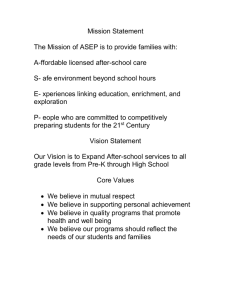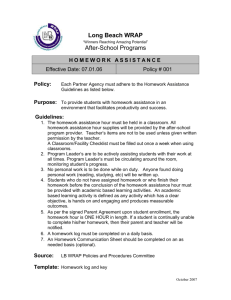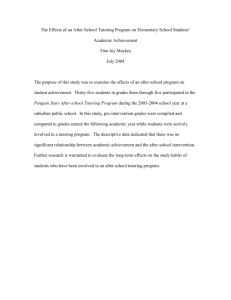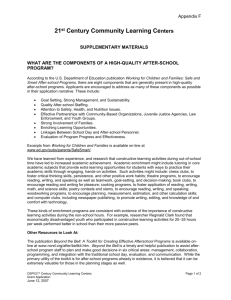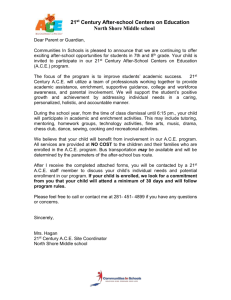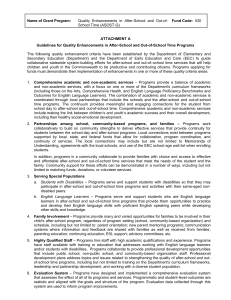Unsupervised And Unsafe - Pennsylvania Partnerships for Children
advertisement
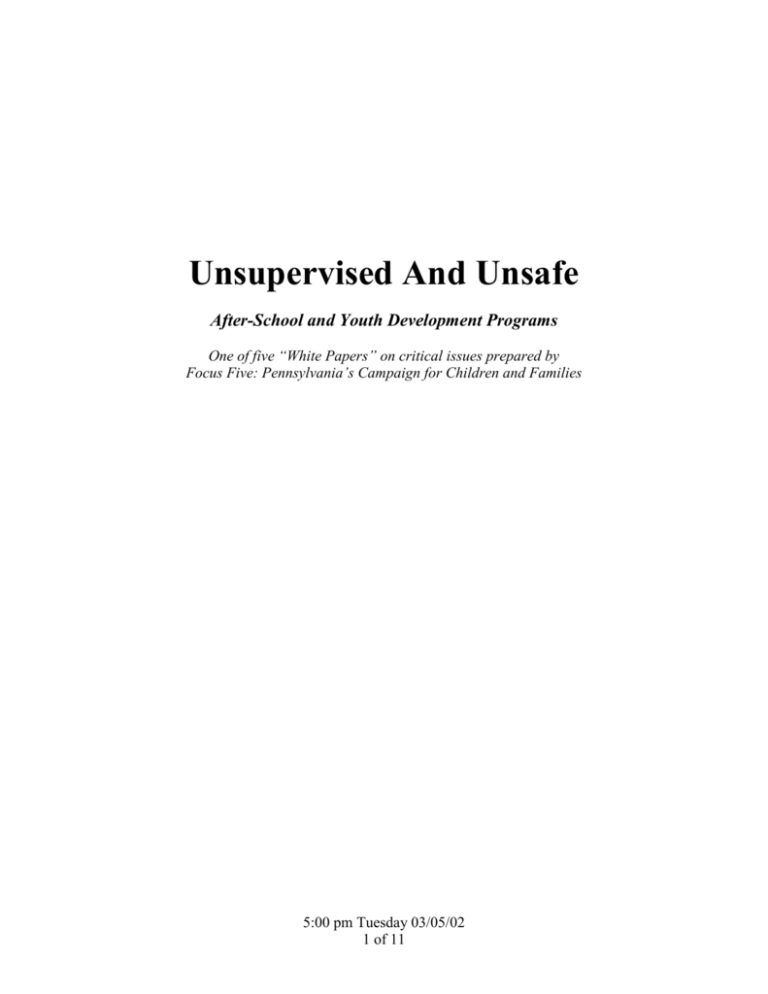
Unsupervised And Unsafe After-School and Youth Development Programs One of five “White Papers” on critical issues prepared by Focus Five: Pennsylvania’s Campaign for Children and Families 5:00 pm Tuesday 03/05/02 1 of 11 Unsupervised And Unsafe After-School and Youth Development Programs The Problem is Real What happens to our children after the school bell rings? That is a question facing more and more parents in Pennsylvania. With most children now living in families with a single parent or both parents working outside the home, lack of supervision during the after-school hours is a serious and growing problem. In 69% of all married-couple families with children ages 6 to 17, both parents work outside the home.1 In Pennsylvania, at least 1.27 million children are in families with all parents working,2 Across the country, there are approximately eight million children ages 5 to 14 that spend time without adult supervision on a regular basis. Four million of these children are between the ages of 5 and 12.3 The differential between the time children leave school and the time parents get home from work can amount to 20 to 25 hours per week.4 The implications of this lack of supervision and support during the after-school hours are grave: Studies by the FBI and others have found that the peak hours for juvenile crime and victimization are from 2 p.m. to 8 p.m.5 1 U.S. Bureau of Labor Statistics, 2000: National Institute on Out-of-School Time, Center for Research on Women, Wellesley College, “Fact Sheet on School Age Children’s Out-of-School Time,” 2001. 2 Pennsylvania Partnerships for Children, "The State of the Child in Pennsylvania, A 1997 Guide to Child Well- Being in Pennsylvania Counties," State of the Child in Pennsylvania Fact Book Series, (Harrisburg, PA: Pennsylvania Partnerships for Children, 1997). Includes families of children age 14 and under with a single parent working and two-parent families with both parents working. 3 Miller, 1999, Hofferth & Jankuniene, 2000 4 Working for Children and Families: Safe and Smart Afterschool Programs, Departments of Education and Justice, 2000; 21st Century Community Learning Centers: Providing Quality Afterschool Learning Opportunities for America’s Families. 5 21st Century Community Learning Centers: Providing Quality Afterschool Learning Opportunities for America’s Families. 5 p.m. Tuesday 03/05/02 2 Violent crimes by juveniles – murder, sexual assault, robbery and aggravated assault – peak between 3 p.m. and 4 p.m., the hour at the end of the school day.6 The after-school period from 2:00-8:00 p.m. is the time that teenagers are most likely to commit crimes, be victims of crime, get in an automobile accident, engage in sex, smoke, drink or use drugs.7 Nearly 4.5 million children age 14 and younger are injured in their homes every year, and most unintentional injury-related deaths occur when children are out of school and unsupervised. 8 Children without adult supervision are at significantly greater risk of truancy, poor grades, risk-taking behavior and substance abuse.9 Without educational success and competencies, children are less likely to graduate and be prepared to enter employment and higher education opportunities. Instead of growing into a contributing workforce, they become a drain on society’s resources. Children’s most common after-school activity is watching television, which can encourage aggression and discourage literacy.10 These after-school hours represent more than a period of high risk. They also represent missed opportunities – lost hours that could be filled with activities to help children and teens build their skills and prepare to be productive and successful adults. Without a concerted effort from state government to support community action to give children opportunities for constructive activities in safe places, many of Pennsylvania’s children will continue without supervision. Without supervision, these children will remain exposed to violence and crime, be presented with many more opportunities to experiment with risky behaviors like drugs, alcohol, and smoking, and go without extra help to improve their performance in school. The Solution is Clear The challenge, while daunting, is not overwhelming. Research and experience have shown that there is a solution. All that is needed is the will and the investment. The evidence is clear and compelling: National Center for Juvenile Justice, 1999; “Afterschool Alert Poll Report, A Report of Findings From the 1999 Mott Foundation/JC Penney Nationwide Survey on Afterschool Programs, January 2000. 7 Safe and Smart: Making After-School Hours Work for Kids, U.S. Department of Education and U.S. Department of Justice, June 1998. 8 Karasik, S., 2000; National Institute on Out-of-School Time, Center for Research on Women, Wellesley College, “Fact Sheet on School Age Children’s Out-of-School Time,” 2001. 9 Dwyer, et.al., 1990; Pettit, et al., 1997; National Institute on Out-of-School Time, Center for Research on Women, Wellesley College, “Fact Sheet on School Age Children’s Out-of-School Time,” 2001. 10 U.S. Department of Justice; U.S. Department of Education (1998). 6 5 p.m. Tuesday 03/05/02 3 After-school and youth development programs can enhance productivity by giving working parents peace of mind, knowing that their children are safe and supervised until the workday ends. These programs give students access to constructive activities that can improve their performance at school, arm them with the tools to resist risky behavior like drug and alcohol use, and build skills to prepare them for college and the workforce. Quality after-school programs can help students improve their performance in school. Studies have shown that students participating in effective after-school programs got better grades,11 had better school attendance,12 and dropped out less often than children who were not in these programs.13 Research also showed that children in after-school programs behaved better in class.14 Here in Pennsylvania, the RAND Corporation conducted an evaluation of after-school programs in the Philadelphia area. The evaluation revealed that fourth-graders in the program outperformed comparison students in reading, language arts, and math.15 Quality after-school programs can prepare teens for college. Children and teens participating in effective after-school programs have been found to be more likely to go on to college after high school.16 For example, the Center for the Study and Prevention of Violence’s Blueprints study of the Quantum Opportunities Program showed that teens were twice as likely to go on to higher education after high school than similar youth not participating in the program.17 Quality after-school programs can help keep kids -- and neighborhoods -- safe. Quality after-school programs have been shown to reduce the chance that a 11 A Decade of Results: The Impact of the LA's BEST After School Enrichment Program on Subsequent Student Achievement and Performance, UCLA Center for the Study of Evaluation, June 2000; Hamilton, L.S. and Klein, S.P. (1998); Achievement Test Score Gains Among Participants in the Foundations SchoolAge Enrichment Program. Santa Monica, CA: RAND Corporation. S.M. Ross, T. Lewis, L. Smith, and A. Sterbin; Evaluation of the Extended-Day Tutoring Program in Memphis County Schools: Final Report to CRESPAR (Memphis, TN: Center for Research in Educational Policy, University of Memphis, 1996). 12 Paula J. Gregory, Youth Opportunities Unlimited: Improving Outcomes for Youth Through After School Care. (Manchester, NH: University of New Hampshire, 1996); McLennan Youth Collaboration, Inc., Communities in School Case Management Staff Evaluation (Waco, TX: Lighted Schools, 1997). 13 J.A. Cardenas et al., "The Coca-Cola Valued Youth Program: Dropout Prevention Strategies for At-Risk Students," Texas Researcher 3 (111-130); Coca-Cola Valued Youth Program, Proposal submitted to the Program Effectiveness Panel of the U.S. Department of Education (Washington, D.C.: U.S. Department of Education, 1991). 14 After-School Programs: Keeping Children Safe and Smart, U.S. Department of Education and U.S. Department of Justice (June 2000). 15 Hamilton, L.S. and Klein, S.P. (1998) Achievement Test Score Gains Among Participants in the Foundations School-Age Enrichment Program. Santa Monica, CA: RAND Corporation; 21st Century Community Learning Centers: Providing Quality Afterschool Learning Opportunities for America’s Families. 16 Janie Funkhauser, et. al., Extending Learning Time for Disadvantaged Students (Washington, D.C.: U.S. Department of Education, 1995); UCLA Center for the Study of Evaluation, June 2000. 17 Blueprints for Violence Prevention (1998). 5 p.m. Tuesday 03/05/02 4 participating child or teen is a victim of a crime.18 Studies also show that quality after-school programs can reduce the likelihood that participating teenagers will commit crimes, and can reduce crime in the neighborhood of the program.19 Quality after-school programs can help kids avoid risky and harmful behavior. Students who spent time in extracurricular activities like after-school programs were found to be 49% less likely to use drugs and 37% less likely to become teen parents.20 Anti-smoking activities in after school programs are an important component of Michigan’s tobacco prevention efforts, which have contributed to a 28% drop in teen smoking in just four years.21 Other studies found that students in after-school programs were less likely to have a child during their high school years.22 Quality after-school programs can save tax dollars. Nine out of ten police chiefs believe that we will pay more in crime, welfare and other costs later, if we don’t invest in after-school and youth development programs today.23 One study by the Center for the Study and Prevention of Violence showed that an effective afterschool program saves $3 for every $1 that is spent.24 Quality after-school care programs can help parents to be more productive workers. Surveys indicate that quality child care, including after-school care, can increase parent productivity in the workplace because they miss less time from work and are more confident of their child’s well-being.25 In sum, making the commitment to improve the safety and broaden the learning opportunities of our children through after-school programs can: Provide young people with a safe, supervised environment 18 U.S. Department of Education and U.S. Department of Justice (1998).Baltimore Police Department Division of Planning and Research, Juvenile Victimizations Comparison for Goodnow PAL Center Area (Baltimore, MD: Baltimore Police Athletic League, 1998). 19 McLennan Youth Collaboration, Inc., Communities in School Case Management Staff Evaluation. (Waco, TX: Lighted Schools, 1997); P. Schinke, M. Orlandi, and K. Cole, "Boys and Girls Clubs in Public Housing Developments: Prevention Services for Youth at Risk," Journal of Community Psychology, OSAP Special Issue (1992). 20 U.S. Department of Health and Human Services (1996). Adolescent Time Use, Risky Behavior, and Outcomes: An Analysis of National Data. Washington, D.C.; National Institute on Out-of-School Time, Center for Research on Women, Wellesley College, “ Fact Sheet on School Age Children’s Out-of-School Time,” 2001. 21 Michigan Teen Smoking Rate Takes Significant Drop, Michigan Department of Community Health Press Release, January 11, 2002 (citing the Michigan 2001 Youth Tobacco Survey). 22 After School Programs: An Analysis of Need, Current Research and Public Opinion, The National Center for Schools and Communities (New York, NY: The After School Corporation 1999). 23 Stephen D. Mastrofski and Scott Keefer, Poll of Police Chiefs Conducted for Fight Crime: Invest in Kids, October 1999 (855 chiefs surveyed). 24 Blueprints for Violence Prevention: Quantum Opportunities Program, Center for the Study and Prevention of Violence, Institute of Behavioral Science, University of Colorado at Boulder, 1998. 25 Harris Poll national survey, January 14-18, 1998. Parents Magazine national survey, August 1997. 5 p.m. Tuesday 03/05/02 5 Keep parents on the job by assuring them of their children’s safe care Give young people more and better learning opportunities to improve their performance in school Make neighborhoods safer by steering youths away from trouble and reducing juvenile crime and violence Reduce drug and alcohol abuse Decrease the numbers of teen pregnancies Reduce the numbers of children injured during unsupervised time Prepare young people for college and the workplace There is so much to gain. Pennsylvania cannot afford to let this important opportunity slip away. The Need is Great There is a chronic shortage of after-school programs available to serve children. Demand for school-based after-school programs outstrips supply at a rate of about 2 to 1.26 Despite strong research-based evidence demonstrating the effectiveness of after-school programs, services have not kept pace. A Mott Foundation/JC Penney poll indicates that less than 4 out of 10 voters say their community provides after-school programs. If the problem isn’t addressed right away, it promises to get much worse before it gets better. The U.S. General Accounting Office (GAO) projects that the need for school-age care could exceed the available resources by as much as 4-to-1 in some cities this year.27 In rural areas, experts assert that the availability of school-age care covers only about one-third of the population of children with employed parents.28 The need is great here in Pennsylvania as well. In a recent statewide survey, more than half of those responding said it was difficult for parents to find affordable, quality afterschool programs in their area. The current federal and state commitment to providing more after-school opportunities falls far short of meeting the need. Total funding from the two largest federal funding programs, the Child Care Development Block Grant and the 21st Century Community Learning Centers, 26 Safe and Smart: Making After-School Hours Work for Kids, U.S. Department of Education and U.S. Department of Justice, June 1998. 27 U.S. General Accounting Office, 1998; National Institute on Out-of-School Time, Center for Research on Women, Wellesley College, “ Fact Sheet on School Age Children’s Out-of-School Time,” 2001. 28 The David and Lucile Packard Foundation (1999). When school is out, The Future of Children, 9(2). Los Altos, CA: Author; 21st Century Community Learning Centers: Providing Quality Afterschool Learning Opportunities for America’s Families. 5 p.m. Tuesday 03/05/02 6 serve fewer than 2 million of the 35.8 million children ages 5-13 in this country. 29 The small portion of these funds reaching Pennsylvania is enough to fund only about 18 after-school programs across the entire state in the first two years of the program.30 Unlike more than half the other states, Pennsylvania does not have an initiative specifically supporting local after-school programs. However, last year the state allocated $15 million in Temporary Assistance for Needy Families (TANF) funds for youth development programs. This is a promising development, but the initiative serves a small fraction of those children who need after-school activities. The state’s subsidized child care funding is an important revenue source used to support after school and youth development programs, particularly for younger school-age youth. These dollars, however, are limited in their availability, purpose and eligibility requirements, and are not sufficient to support the many school age children and youth who are not currently able to access these services.31 As a result of these shortages of available after-school programs, parents and grandparents across Pennsylvania worry each day about what their children will do, and what might happen to them, while they’re left unsupervised. Think about it. It shouldn’t be that way. And it doesn’t have to be that way any more – not in Pennsylvania. The Support is Strong After-school programs carry strong support among law enforcement, educators, parents and the general public. Increasingly, the public sees the value of after-school programs, for their children and for the community at large. According to public polling data from the 1999 and 2000 Mott Foundation/JC Penney survey, 92% of voters agreed that access to after-school programs or some type of organized, supervised activity is important, and that access must be available to all school-age children and youth. At least 75% of voters in every 29 U.S. Census Bureau, 2001, ACYF, DHHS, 2001, U.S. Dept. of Education, 2001; National Institute on Out-of-School Time, Center for Research on Women, Wellesley College, “ Fact Sheet on School Age Children’s Out-of-School Time,” 2001. 30 Youth Violence, Pennsylvania Partnerships for Children (2000) Recommendations for improving this program are contained in the school readiness white paper, “Ready or Not.” 31 5 p.m. Tuesday 03/05/02 7 demographic subgroup feel that after-school programs are a necessity. This consensus holds across partisan lines as well as geographic regions.32 Another survey found that 88% of voters believe after-school programs are a necessity. Nearly 40% believe that the biggest problem facing children today is that they are alone and unsupervised.33 In Pennsylvania, support for after-school programs is very strong. A recent survey of Pennsylvanians34 found that: 78% think that providing after-school opportunities for children and teens should be a top priority for state government Only one in four think the state is doing enough to fund after-school programs for children and teens 71% support expanding after-school programs even if it means state government must spend more money to do it Support in Pennsylvania for after-school programs is high across demographic groups and party lines. Support is strong among all age groups, including older voters At least 70% of voters in each party give after-school programs a high priority Only one-third of Republican voters believe that the state is doing enough to support after-school programs, while six in ten support more state funding Support for more funding is consistently high – over 70% -- among both men and women Law enforcement officials strongly support expansion of after-school programs, recognizing them as potent tools in the fight against crime. Nine in 10 police chiefs believe that expanding after-school programs will “greatly reduce youth crime and violence.” 32 Afterschool Alert Poll Report, A Report of Findings from the 1999 Mott Foundation/JC Penney Nationwide Survey on Afterschool Programs, January 2000. 33 Afterschool Alliance (January 2000), Afterschool alert: poll report; National Institute on Out-of-School Time, Center for Research on Women, Wellesley College, “ Fact Sheet on School Age Children’s Out-ofSchool Time,” 2001. 34 Statewide Survey of 800 Likely Pennsylvania Voters, Lester & Associates, November 2001. 5 p.m. Tuesday 03/05/02 8 The same percentage believes “if America does not make greater investments in after-school and educational child care programs to help children and youth now, we will pay far more later in crime, welfare, and other costs.”35 Educators have long recognized the need for after-school programs as a way to improve students’ success in school. In a 1989 Harris poll, 84% of school principals agreed there was a need for afterschool programs. In a 2001 survey, nearly nine in ten principals said they believe after-school programs to be important to a school, and more than six in ten considered them “extremely important.”36 The Objective is Achievable Effective youth development programs during the after school hours exist in some communities across Pennsylvania. But these programs are not available on the scale necessary to help many of the children who would benefit from them. Sufficient programs will not develop on their own without state government’s support for local community partnerships that can deliver quality services. It is our position that Pennsylvania should set as a goal that school-age children and teens have access to quality after-school and youth development programs that provide: A safe environment with structured adult supervision Learning opportunities designed to improve educational achievement Training to teach kids to stand up against drugs, alcohol, tobacco and violence, including a comprehensive plan to reduce use of tobacco, a key “gateway” drug. Support for the successful transition from youth to adulthood through youth employment and training opportunities This can only be achieved through action by state government to: 35 Increase support for after school and youth development programs across the state by pooling and expanding upon the federal 21st Century Community Learning Centers program and the state’s current $15 million allocation of TANF dollars Fight Crime: Invest in Kids (2000), America’s Child Care Crisis: A Crime Prevention Tragedy. 36 Principals and After-School Programs: A Survey of PreK-8 Principals, Survey by Belden Russonello & Stewart of 800 Principals, National Association of Elementary School Principals (2001). 5 p.m. Tuesday 03/05/02 9 for youth development. This approach will increase access to after-school and youth development programs in both rural and urban areas, and would direct support for programs that are based on proven and demonstrated strategies for youth development. The initiative would support a range of additional afterschool and youth development programs across the state, including homework assistance and extra learning opportunities, tobacco prevention and cessation activities, mentoring, and training programs that build skills for entering the workforce. Provide assistance through a statewide technical resource center network to help local programs deliver effective, research-based activities and to monitor program performance to ensure that they are helping students improve their school performance and other key measures of success. This technical assistance should include assistance with the development of agreements to use school facilities, strategies to secure additional funding from federal and other sources, methods for connecting homework-assistance activities to students’ academic performance needs, and establishment and monitoring of performance measures to gauge success. This assistance could be provided by expanding the current responsibilities of Pennsylvania’s four regional Child Care Resource Development Offices. Provide incentives for counties to redirect existing child welfare funding to effective after-school and youth development programs from high-end crisis intervention and placement. This budget-neutral approach will promote preventive activities and services. Ensure that sufficient resources are available through the state’s current subsidized program to ensure access to school-age services for more eligible working families, and to avoid the development of waiting lists under the state’s subsidized program. The Time is Now The entire state benefits when we give our children and youth the tools and opportunities they need to grow into responsible adults – good workers and good citizens contributing to the well-being of our commonwealth. After-school and youth development programs have proven to be a critical component in improving the safety of our children and providing extra learning opportunities that can improve school performance while reducing crime. The Focus Five for Kids coalition believes that now is the time to make the commitment to implement an action agenda that invests in our children’s increased safety and supports their journey to responsible adulthood. 5 p.m. Tuesday 03/05/02 10 The problem of unsupervised children in the after-school hours is real. The proof that after-school programs can keep kids safe and help them succeed is clear. The need for quality after-school programs is great. The support for after-school programs from law enforcement, parents, educators and the public is strong. The objective of providing access to quality after-school and youth-development programs to those who need it is achievable. If all this is true, then why are there still children and teens in Pennsylvania who are unsupervised and unsafe? Once again, all that is missing is the will and the commitment from our government leaders to make it happen. Please join us in asking the gubernatorial candidates to make that commitment by asking one simple, vital question: “Hey, What About the Kids?” 5 p.m. Tuesday 03/05/02 11
